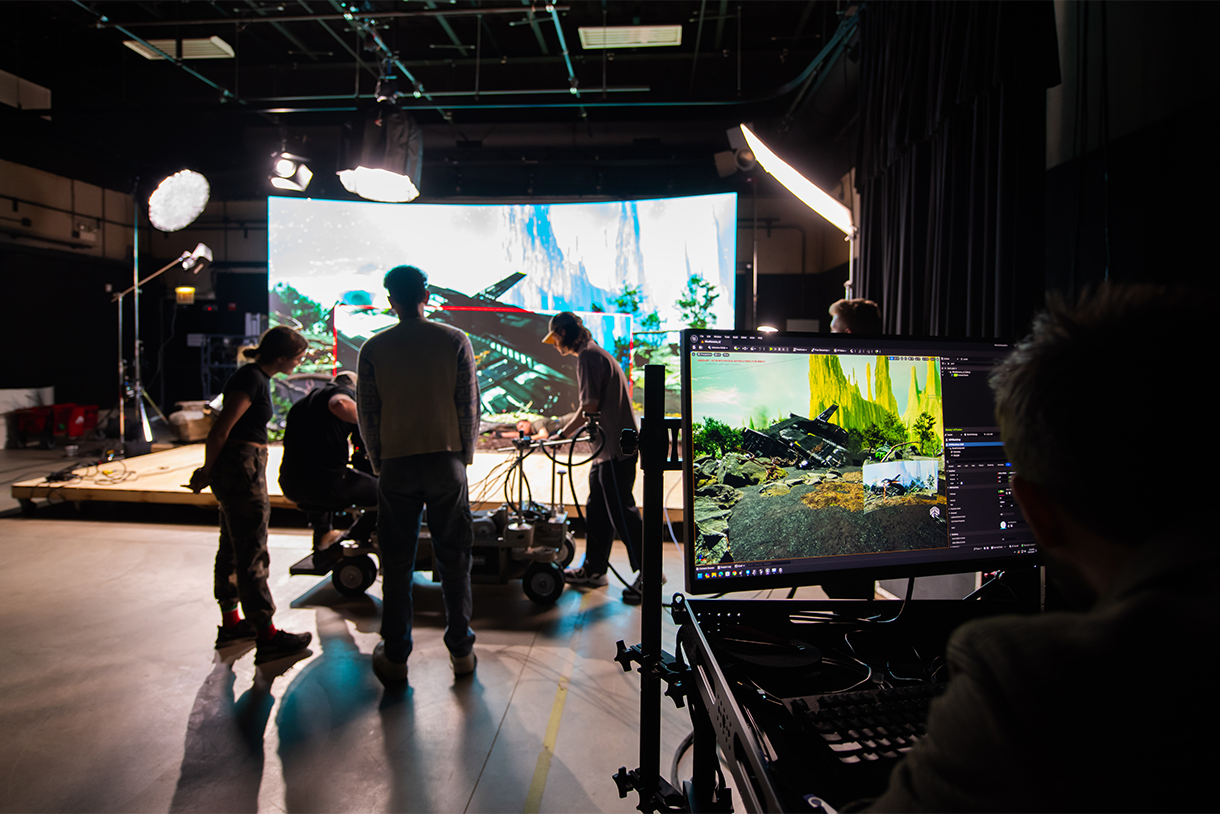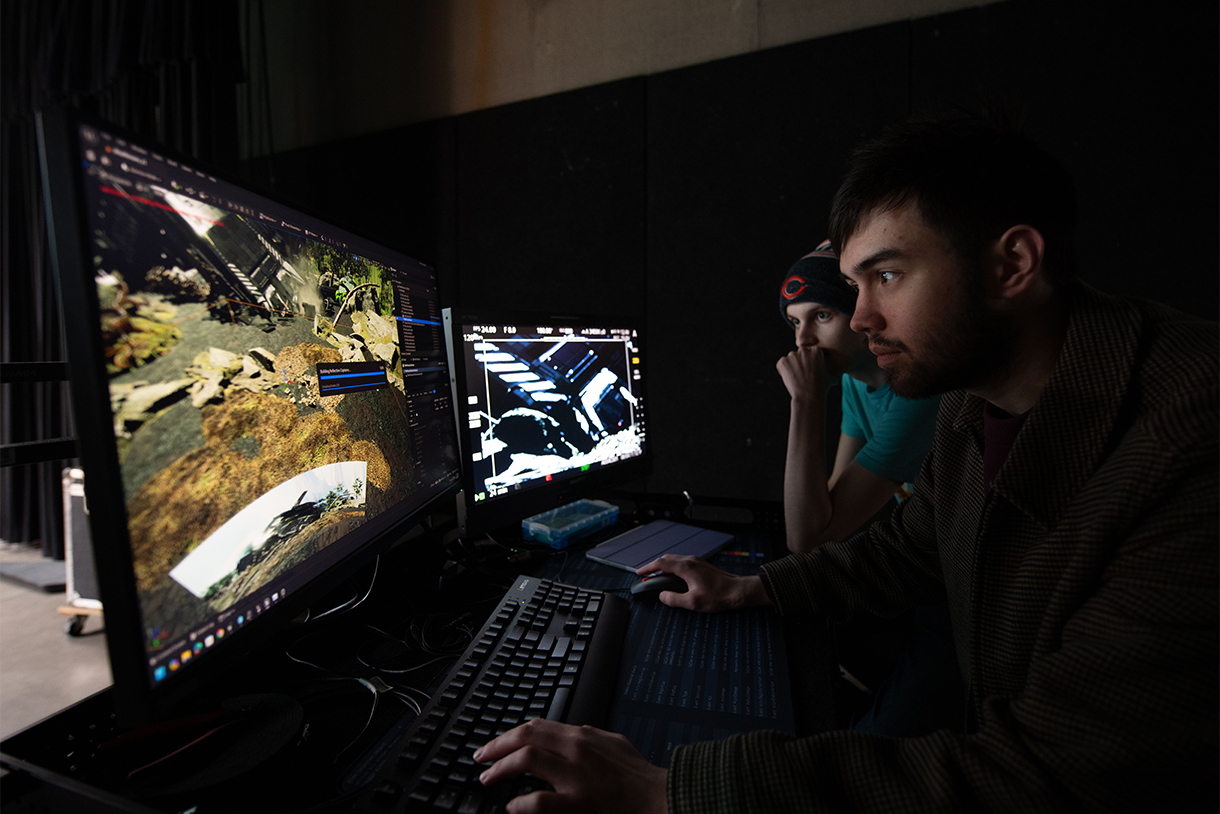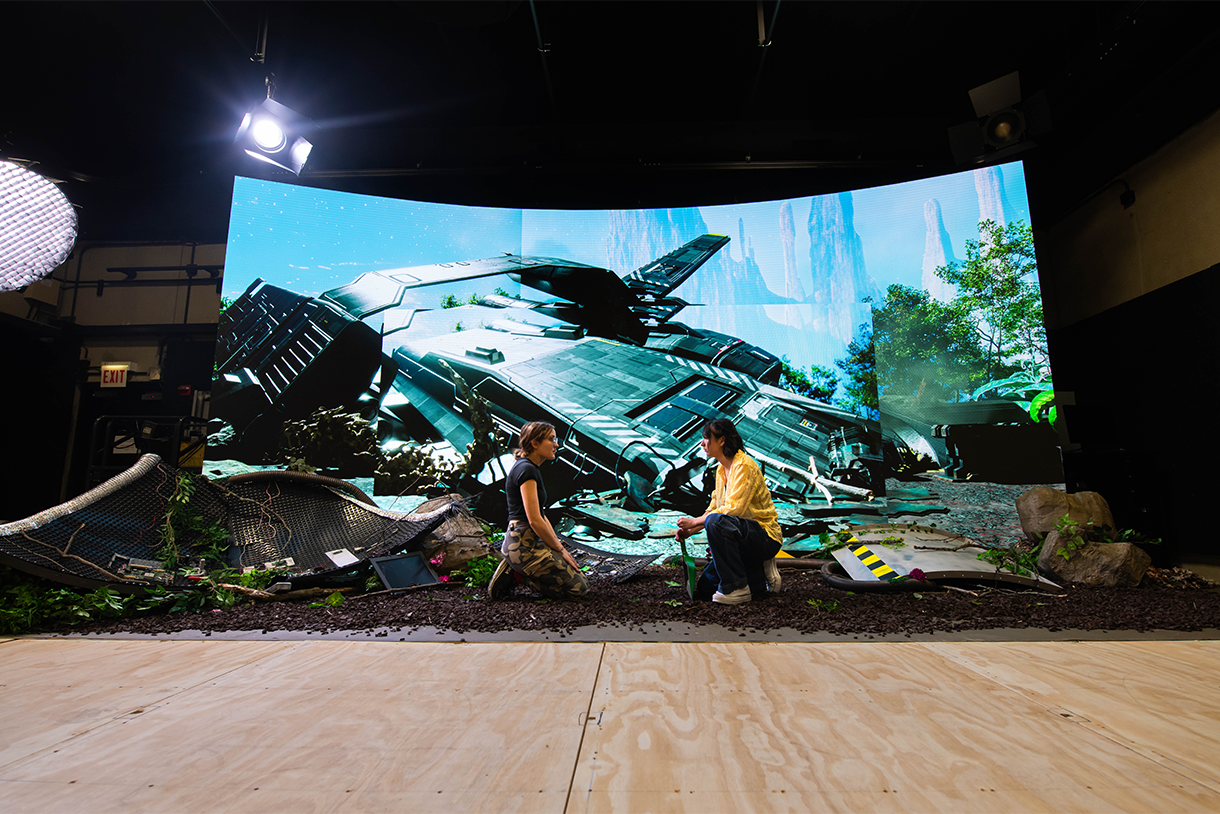Creativity Without Limits: Columbia Students Bring Imaginary World to Life With Virtual Production
Bringing Film and Television Senior Hannah Brumfield’s interstellar script to the screen posed potential set design challenges. But by using new virtual production technology at Columbia College Chicago to create the imaginary planet in Brumfield’s script — complete with extraterrestrials and a crashed spaceship — students are unleashing possibilities Brumfield had never envisioned.
Virtual production blends traditional filmmaking techniques with digital, real-time technology from game engines to build fictional worlds using an LED wall, commonly known as a “volume.” With a volume now available to them along with Unreal Engine 3-D software, Columbia students can digitally build make-believe settings and characters, just as filmmakers have done for “The Mandalorian,” “Avengers: Endgame,” “The Batman,” and many films and TV shows since.
“We are no longer limited to physical environments,” says James Brust, associate professor of instruction “Filmmaking students — the production designers, the producers, the cinematographers, the lighting teams — all get to work with our student animators and game artists and designers to create fantastical environments that weren't previously possible in student film productions.”
Years of Planning Pay Off for Students Across Disciplines
This state-of-the-art filmmaking technology comes to Columbia after years of planning and preparation.
"It's great seeing James and his students working on our new video production wall,” says interim Media Arts Dean Tom Dowd. “We've been working for years to get Stage 3 at our Media Production Center configured to support the installation, and Columbia’s facilities, IT, and engineering teams have been great allies in getting the environmental and electrical systems to the point where we could set it up this semester. Students across multiple disciplines will be able to use the wall to let their creativity run rampant as we can now turn a set into any location we want."
Brust’s virtual production class brings together students from two departments — Cinema and Television Arts (CTVA) and Interactive Arts and Media. As they learn how to use the technology, each student contributes their unique skill set and professional passion to projects – whether it be cinematography, directing, production design, lighting, animation, or game art and design. They are broken out into two teams, with one team focused on physical production and the other zeroed in on the virtual aspect.
Students Collaborate Using Volume to Make Science Fiction Film
For the alien film entitled “What Remains,” CTVA students Brumfield (screenwriter and co-director) and Senior Frida Arellano (physical art department team member) shared their ideas about what the spaceship should look like with the virtual team. This collaboration led to that spaceship and the alien planet coming to life on screen in combination with physical set design and the actor portraying the wounded pilot of the spaceship.
“On stage, I'm working with my co-director Jayden Ray to merge a virtual screen with a physical world,” Brumfield says. “Frida had a lot of input regarding what spaceships would be easy for us to adapt into a physical realm. The virtual art department then took elements from all these different assets and merged them into our own creative world.”
Senior Annie Mainwaring, a Computer Animation major, is part of that virtual art team.
“Everything you see on the volume is what we put together,” she says. “We take different assets and accumulate them into an environment and then try and match it up with the real prop things to make a cohesive scene.”
Having students from different disciplines work together on virtual production mimics the new world order in filmmaking, with decisions made about special effects in real-time versus later in postproduction.
Virtual Production Experience Prepares Students for Real-World Careers
At Columbia, students appreciate hands-on learning opportunities in virtual production environments, gathering knowledge on everything from the technology itself to new film production workflows to the jargon used by other disciplines.
“Virtual production is a very big new thing in visual effects. And I definitely see it as having a big future in the cinema and television space,” Trevor Bucek, a senior in Computer Animation. “And as an environment modeler primarily, this is right up my alley.”
For Jayden Ray, co-director of “What Remains” and a first-year student in Film and Television, the volume was a driving force in coming to Columbia.
"I hope to be able to work with this fluently because as our professor says all the time, not many people are fluent in this because it's so new,” Ray says. “And as a new up-and-coming film person, I just want to be fluent in the technology that's used today.”
Take an inside look at Columbia's volume by watching the video below:
Recent News
- The Levin Family Expands Student-Focused Funds to Support Columbia Students
- Ryan Argast '15 to Sing National Anthem at May 17 Cubs Game
- Columbia to Confer Honorary Degrees on Two Higher Education Trailblazers at its May 2024 Commencement
- Ask the Expert: How to Style Yourself for Graduation
- Creativity Without Limits: Columbia Students Bring Imaginary World to Life With Virtual Production


